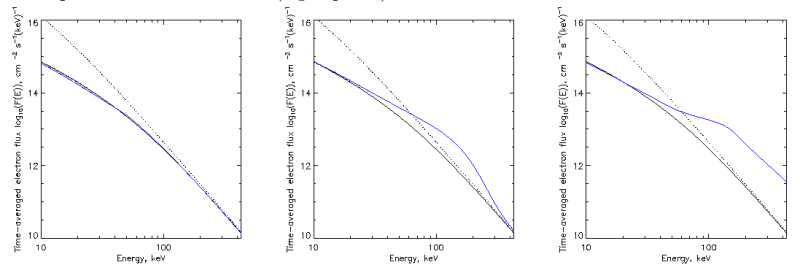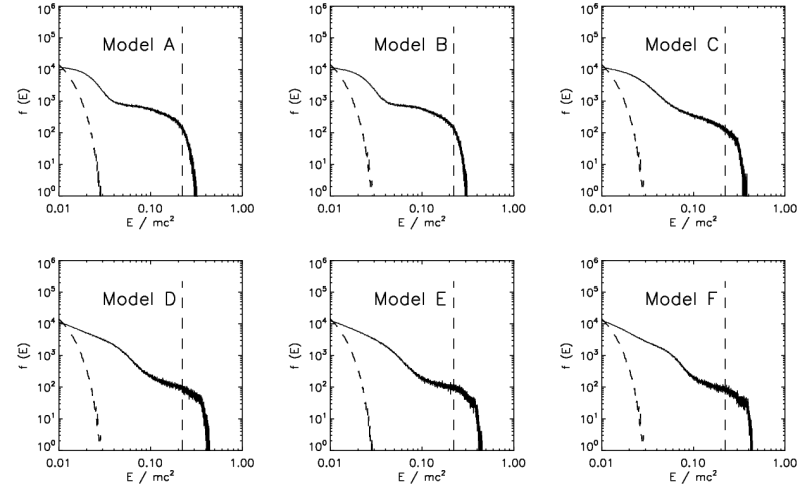Electron re-acceleration and HXR emission
| Nugget | |
|---|---|
| Number: | 194 |
| 1st Author: | Heather Ratcliffe |
| 2nd Author: | Marian Karlický and Eduard Kontar |
| Published: | 2013 February 18 |
| Next Nugget: | Burst-on-Tail (BOT) |
| Previous Nugget: | Passages of Electron Beams |
Introduction
During solar flares, vast amounts of energy are released from the Sun's magnetic field, part of which leads to particle acceleration. Fast electrons thus produced can propagate along a coronal magnetic loop, and produce Hard X-ray (HXR) emission at its footpoints by collisional bremsstrahlung in the dense chromosphere. This HXR emission is one of the primary diagnostics of energetic electrons, and is usually interpreted using the "thick target" model. This assumes, among other things, that the distribution function of the emitting electrons is modified only by collisions.
However, when such fast electron beams propagate in a plasma, Langmuir (plasma) waves are generated. These waves are strongly affected by density inhomogeneities, or by wave-wave interactions, and this evolution can have significant effects on the electron distribution. Several simulation methods are applicable in this situation. In this Nugget we show some quasilinear and PIC (particle-in-cell) simulations of the electron evolution and briefly discuss the effects on HXR emission.
Quasilinear Simulations
Our model (based on ref. [1]) describes collisional relaxation of the energetic power-law distribution. We consider firstly a simplified model including only collisions, and then the relaxation including wave generation, and evolution.

The primary quantity of interest is the time-averaged electron flux as a function of electron energy, which is closely related to the observed HXR emission. We show this for the simulation models with and without Langmuir-wave generation (left panel), with Langmuir-wave generation and evolution due to density inhomogeneities (middle panel) (see ref. [3] for details), and finally with wave-wave processes also included (right panel).
We see from Figure 1 that the Langmuir-wave generation alone has a very weak effect, which confirms a well-known previous result. However, the time evolution of the Langmuir waves can produce significant changes in the HXR emission. For the model parameters chosen, this occurs primarily between 20 and 200 keV, and within this range we can expect an increase in HXR emission of an order of magnitude (Figure 1).
PIC simulations
It is also possible to use a 3D "particle-in-cell" (PIC) simulation to consider the problem of a monoenergetic beam injected into a plasma, with the effects of wave-wave interactions included. In these PIC simulations (ref [3]) the proton-electron mass ratio was taken to be 16 for computational reasons, but that is sufficient for these simulations. The initial electron beam was homogeneous throughout the numerical box of the simulation, and an appropriate return current introduced to keep the total current in the system zero. Periodic boundary conditions were used.

Using this model we made several computational runs, in which we also changed
the magnetic field, oriented in the beam propagation direction.
In Fig. 2 we present the the resulting electron energy
distributions at the (normalized) time t = 200, for the magnetic field
expressed through the ratio of the
electron-cyclotron frequency to the
plasma frequency, equal to 0.0, 0.1, 0.5, 0.7,
1.0, and 1.3, respectively (models A-F).
As can be seen here, there are electrons
accelerated above their initial energy, and the number of these increases with the magnetic field strength.
This is due to the
Weibel instability, which in the 3-D beam-plasma system with low magnetic fields reduces this
acceleration process.
Complementary approaches
The two simulation methods presented here are very different, and each has its advantages and disadvantages.
Quasilinear simulations use weak turbulence theory. Computationally such simulations are fast, and the beam-plasma interaction is well treated by such a model. PIC simulations are computationally demanding and limited to short time and spatial scales, and thus require such approximations as a small electron-proton mass ratio, and a small number of particles. However, the effects of magnetic field can be included, and the treatment is fully 3-D and self-consistent. Thus the two methods offer very good independent confirmation, and together give a strong argument for such an acceleration effect occurring.
Conclusions
The effects of Langmuir waves on HXR emission from an electron beam were considered a long time ago, but only as an energy loss process for the beam, where they were found to have no effect on the time-averaged electron spectrum. However our simulations found significant electron acceleration, due to the redistribution of energy from below to above 20 keV. This shows that one needs far less electrons to produce the HXR spectrum as observed by, for example, RHESSI. When this HXR spectrum is analysed to deduce the electron spectrum generating the HXR emission via use of standard inversion techniques, this could be substantially overestimated (refs [2] and [5]).
References
[1] Oscillations and instability of a weakly turbulent plasma
[5] Effect of turbulent density-fluctuations on wave-particle interactions and solar flare X-ray spectra